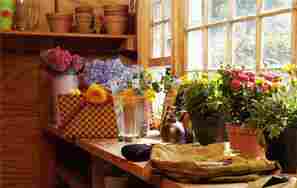Sandy soils are well aerated and very free draining, they warm up quickly in spring giving plants a quicker start into growth. There is a price to pay for this advantage, they are both thirsty and hungry thus will need regular watering and applications of fertilizers.
Plants that thrive on sandy soils are often accustomed to low nutrients and drought in their natural habitat. how ever you might want something more exciting.
This soil can be improved by adding lots of nutrient rich organic matter horse or cow or garden compost. Some extra top soil can be added. Some soil is mostly sand then you really have to enrich, if its a loose loamy sandy soil then you might not have to do anythign. Look aroudn the neighbourhood and see whats growing near by ask advice. Sandy soild can be slightly acid. It might be worht checking the pH.
When you are planting ensure you use a good back fill of top quality muliti purpose and to give additional plant food in the form of balanced, preferably slow release fertilizer.We sell slow high quality release ini our own bags at considerably less then main brands. A liquid feed can be helpfull when they are young. if the drainage is crazy then you might wish to consider lining the plantign area or bed with some pouros matting and or using ground cover on the surface.
Sandy soil and the dry conditions that accompany it need not be an obstacle to an attractive garden. Choosing plants that are well adapted to the conditions is the key. This does not mean that you should not include other plants. But it's good to remind yourself that extra site preparation and time spent watering and fertilizing might be the price you pay.
Sand poses different problems. Water drains through it rapidly, so it's quick to dry in the spring, but it doesn't hold enough moisture for most plants in hot, dry weather. Sandy soil can be improved by adding large quantities of organic material year after year, but this is usually practical only for small areas, such as flower or vegetable gardens. For lawns and other large areas, it makes more sense to plant trees and shrubs that usually grow in sand or tolerate sandy conditions. Irrigation is worth considering is the site if very dry.
You can localise condtions by lining holes for plants that need less drainage. I've seen this done to great effect in a border of annuals. Some flower such as corn flowers annuals will do ok in a sandy soil as long as there is some peat or soil. Start off the seeds and transplant to a plug tray or bedding cell pack and grow on, Pinch back when they are about 6 inches tall to about half that then they will sprout many more shoots. Leave for a few days then transplant into postion. You can repeat this basic process for other annuals.
Trees for sandy soil.
Flowering crabapples tolerate sandy soils and offer a wide range of sizes (6 to 25 feet), shapes (upright to spreading to pendulous), and flower and fruit colors. Choose disease-resistant cultivars and plant in full sun.
Ginkgo (Ginkgo biloba) is an ancient species that's survived virtually unchanged since the days of the dinosaurs some believe its is the mother of all trees. A medium to slow grower, it eventually reaches a height of 15 meters and has clam shaped leaves. Various cultivars range from umbrella-shaped to columnar. It tolerates a wide range of soil conditions, including sand. Has some medicinal uses see the plant page.
A number of common shrubs withstand the dry conditions that come with sandy soil.
Many of them -- such as Japanese barberry (Berberis thunbergi), flowering quince (Chaenomeles lagenaria), gray dogwood (Cornus ragemosa), common smoketree (Cotinus coggygria), common witchhazel (Hamamelis), privets (Ligustrum spp.) - have flowers and interesting or colorful fruits.
Some ornamental ceepers and climbers such as wintercreeper (Euonymus fortunei), Baltic English ivy (Hedera helix baltica), trumpet honeysuckle (Lonicera sempervirens), Hall's Japanese honeysuckle (Lonicera japonica halliana) and hardy grapes (Vitus spp.) will love it.
Fruit such as black current Blue berry
Acacia dealbata
Artemisia pontica
Ballota pseudodictamnus
Brachycome iberidifolia
Ceratostigma willmotianum
Cercis siliquastrum
Cistus
Convolvulus cneorum
Crambe cordifolia
Echiveria
Dictamnus albus
Lavatera Kew Rose
Lampranthus
Lavendula
Papaver orientale
Portulaca grandiflora
Osteospermum
Salvia officinalis tricolor
Yucca gloriosa / filmentosa
Grasses also make a good foil in snady soils and can hide or frame many things. Read about using grasses in your gardening. Click here
LIST TO FOLLOW. but many of the plants for dry areas will do well here also see harsh windy plants
